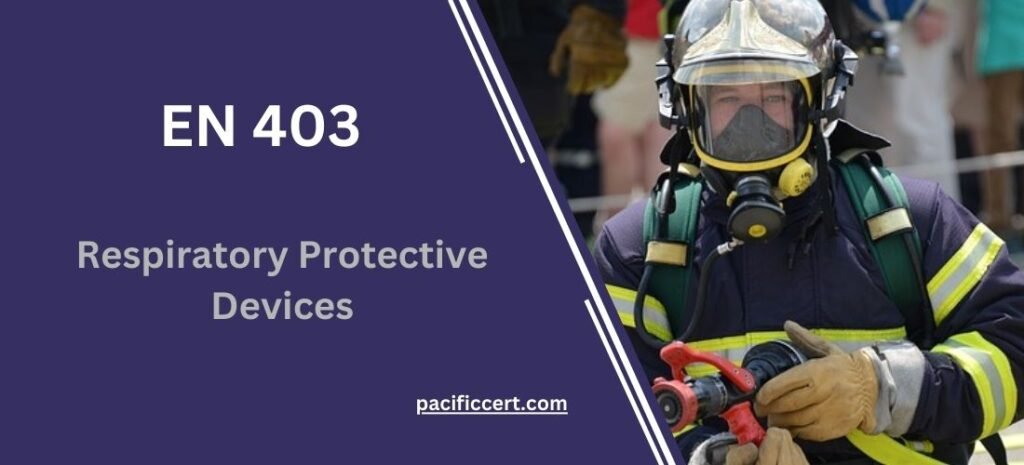
What is EN 403-Respiratory protective devices for self-rescue. Filtering devices with hood for escape from fire-Requirements, testing, marking?
EN 403 specifies the requirements, testing methods, and marking for respiratory protective devices with hood for self-rescue during escape from a fire. These devices are designed to provide respiratory protection to individuals who need to escape from a fire or other emergency situation where the air is contaminated with smoke, toxic gases, or other harmful substances.
The standard sets out the following requirements for respiratory protective devices with hood for self-rescue:
Filtering efficiency
Airflow resistance
Carbon monoxide resistance
Flame resistance
Hood design
Marking and instructions
EN 403 also includes testing methods to ensure that the respiratory protective devices meet the required standards. Including tests for filtering efficiency, carbon monoxide resistance, and flame resistance. So, Compliance with the standard can help to ensure that respiratory protective devices with hood for self-rescue provide effective protection to individuals. During escape from a fire or other emergency situation where the air is contaminated with harmful substances.
Requirements of EN 403
Filtering efficiency: The device must have a minimum filtering efficiency of 90% against particles of size 0.3 μm and larger.
Airflow resistance: The device must have an airflow resistance of no more than 1.5 mbar at a flow rate of 30 l/min.
Carbon monoxide resistance: The device must provide a minimum of 15 minutes protection against carbon monoxide.
Flame resistance: The device must be flame-resistant and not contribute to the spread of fire.
Hood design: The hood must cover the head and shoulders and have a minimum overlap of 50 mm on the torso. It must also provide a tight seal around the neck and shoulders to prevent smoke and other harmful substances from entering.
Size and weight: The device must be lightweight and easy to carry, with a total weight of no more than 1 kg.
Testing:
EN 403 includes testing methods to ensure that the respiratory protective devices meet the required standards. Including tests for filtering efficiency, airflow resistance, carbon monoxide resistance, flame resistance, and hood design.
Marking:
· The device must be marked with the manufacturer’s name, product name, and year of manufacture.
· The hood must be marked with the expiry date and a symbol indicating that the device is for single use only.
· The packaging must be marked with the product name, manufacturer’s name, and batch number.
Therefore, EN 403 can help to ensure that respiratory protective devices with hood for self-rescue provide effective protection to individuals during escape from a fire or other emergency situation where the air is contaminated with harmful substances.
Benefits of EN 403
Effective protection: The requirements and testing methods specified in the standard ensure that respiratory protective devices with hood for self-rescue provide effective protection to individuals. During escape from a fire or other emergency situation where the air is contaminated with harmful substances. Such as smoke and toxic gases.
Safety: Compliance with the standard can help to improve safety for individuals working in environments where there is a risk of exposure to harmful substances. Such as firefighters and other emergency responders.
Quality assurance: Compliance with EN 403 provides assurance that respiratory protective devices with hood for self-rescue meet strict quality and performance standards. Ensuring that they are fit for purpose
Clarity: This standard provides clear and specific requirements for the design, and construction. Also, testing of respiratory protective devices with hood for self-rescue. As well as clear marking requirements, which can help to ensure that the devices are used correctly and safely.
Confidence: Compliance with EN 403 can help to build confidence in respiratory protective devices with hood for self-rescue, both among users and regulatory bodies. Which can lead to greater adoption and use of these devices in a variety of settings.
EN 403 can help to improve the safety and effectiveness of respiratory protective devices with hood for self-rescue. Providing greater protection and assurance to individuals in emergency situations.
Who needs EN 403: Respiratory protective devices for self-rescue. Filtering devices with hood for escape from fire. Requirements, testing, marking?
EN 403 applies to manufacturers, importers, and distributors of respiratory protective devices with hood for self-rescue that are intended for use in escape situations from fires or other emergency situations where the air is contaminated with harmful substances. Thus, this includes individuals and organizations involved in the design, production, testing, distribution, and sale of these devices.
Users of respiratory protective devices with hood for self-rescue. Such as fire-fighters and other emergency responders, also benefit from compliance with EN 403. As it helps to ensure that the devices provide effective protection. During escape from a fire or other emergency situation where the air is contaminated with harmful substances.
Regulatory bodies and other organizations responsible for occupational health and safety may also refer to EN 403. As a basis for establishing minimum safety requirements and quality standards for respiratory protective devices with hood for self-rescue.
Pacific Certifications is accredited by ABIS, if you need more support with EN 403, please contact us at +91-8595603096 or support@pacificcert.com
Read About: EN 397:2012+A1:2012







